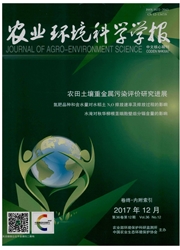

 中文摘要:
中文摘要:
以粤香占和丰美占两种水稻为指示植物,通过水培试验,研究了重金属元素Cd与除草剂苄嘧磺隆(BensulfuronMethyl,BSM)复合污染对水稻的生物学影响。Cd^2+的浓度分别为0、5、10、50、300mg·L^-1,BSM的浓度分别为0、0.1、0.2、0.4、0.6、1.0mg·L^-1。结果表明,随Cd2+浓度的增加,水稻生物量、叶绿素含量下降,过氧化氢酶活性降低,根系外渗液电导率升高,各处理间差异达极显著(P〈0.01),粤香占水稻对Cd的耐受性显著低于丰美占水稻(P〈0.05)。0.1和0.2mg·L^-1的BSM在一定程度上能够缓解Cd对丰美占水稻的毒害作用,但是当BSM浓度达到0.6mg·L^-1以上时,水稻的生物量、叶绿素含量、过氧化氢酶活性又有所下降,BSM对根系外渗液电导率的影响未达显著。用ICP测定水稻地上部和根部Cd含量,分析结果表明,水稻地上部Cd的浓度远低于根部Cd的浓度,且后者是前者的6倍左右。在本实验条件下,当Cd浓度为50和300mg·L^-1时,0.1~0.2mg·L^-1的BSM会显著降低水稻地上部和根部Cd含量(P〈0.01);BSM浓度大于0.4mg·L^-1时,水稻根部Cd含量显著上升(P〈0.05),而地上部Cd含量无显著差异。这说明,BSM抑制了Cd从根部向地上部的迁移。因此,BSM在低浓度0.1~0.2mg·L^-1时,能够缓解Cd对水稻的毒害作用;当BSM浓度达到0.6mg·L^-1并有Cd^2+复合污染存在时,会对水稻植株产生更严重的影响。
 英文摘要:
英文摘要:
Hydroponics experiment was carried out to investigate the biological effects of co-contamination with bensulfuron methyl (BSM) and cadmium on rice. Two cultivars, Yue Xiangzhan and Feng Meizhan were employed as the indicator plants, 0, 0.1, 0.2, 0.4, 0.6 and 1.0 mg·L^-1 of BSM and O, 5, 10, 50 and 300 mg·L^-1 of Cd were designed. The content of Cd in the root and shoot of the rice was measured with ICP. The result indicated that with increasing cadmium concentration, the biomass of the rice, the chlorophyll content and the activity of catalases (CAT) reduced, and there were significant differences between the treatments (P〈0.01), but the solution conductivity increased with increasing of Cd content. The tolerance of Yue Xiangzhan to cadmium was higher than that of Feng Meizhan. 0. 1~0.2 mg·L^-1 BSM could relieve the toxicity of Cd, but the biomass, the chlorophyll content and the CAT activity significantly decreased when BSM exceeded 0.6 mg·L^-1. However, the concentration of BSM did not affect the solution conductivity significantly. The accumulation of Cd in root was about 6-fold that in shoot. When the concentrations of Cd were 50 mg·L^-1 and 300 mg·L^-1, applying 0.1 mg·L^-1 and 0.2 mg·L^-1 BSM could decrease the uptake of Cd. However, when the applied BSM was more than 0.4 mg·L^-1, the accumulation of Cd in root dramatically increased, but there was no significant difference in the Cd uptake by stem, which implied that BSM inhibited the transference of Cd from root to shoot. In conclusion, although the toxicity of Cd to the rice could be relieved when 0.1~0.2 mg·L^-1 BSM were applied, it would be more serious to rice when the concentration of BSM exceeded 0.6mg·L^-1 and coexisted with Cd.
 同期刊论文项目
同期刊论文项目
 同项目期刊论文
同项目期刊论文
 期刊信息
期刊信息
